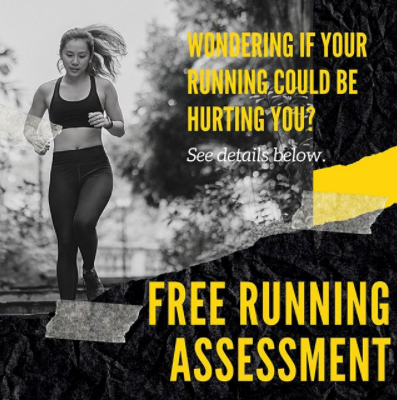Running is a great exercise to help improve your heart, lung, and mental sanity. Did you know your running styles can tell us a lot about how well built your body is to run? There are numerous nuances and tendencies that we can write about to help improve on your run, but the article will be forever long.
An example of a running variable that will impact the stress load on your legs and spine is cadence. Cadence is a factor that has been shown to alter the ground reaction force to your legs and spine. This article will dive into the overall movement pattern and the indications of how you are using your spine and legs. There still needs to be follow-up strength and mobility assessment after you analyze your running style. The movement analyzation will guide on what might be going on during a run, but the follow-up testing will help to validate the theory of what is going on. There is no ONE particular test that will tell you everything. In the clinical world, you need a cluster of tests that will give you a working foundation to start experimenting with.
After you learn about the 3 common running styles, we have an exclusive offer for you. At the end of the article, there is an orange button that you can click on to get your FREE running assessment. We will respond to you and give you instructions on how you can send us your running video. The video will guide us to know which running style you are using. In the email response, we will tell you to perform 3-4 movement tests and report back to us. We will ask about your running goals and your past training history. All of these three major factors will allow us to give you feedback so you can improve and run with ease.
“Spine twist” runner.
With this runner, you will see a washer machine type of rotational motion that occurs in the lower back region. You want a minimal appearance of twisting that appears to be non-existent from an untrained eye.
The lumbosacral region is designed to manipulate the ground reaction force that occurs when your leg hits the ground. The harder your leg hits the ground, the same and equal force travels back up your leg and the spine.
The way your muscles connect and track, your right leg works with your right arm, and your left leg works with your right arm. You can see how the Spiral functional lines produce an “X” cross design which allows your body to more freely and stable, simultaneously. This is the design of a rope.
The tautness of the rope indicates how well the kinetic force is being transferred. The amount of rotation that is demonstrated during a run indicates how loose the crosslink is. The ground reaction force becomes muddled and loses the kinetic chain transfer to the arm and back down to the legs. If you have been following our blog, we have written how the lumbar spine does not favor rotational stress.
The root causes could be many factors but the list includes tight hip joint, improper lumbar spine motor coordination, dysfunctional feet sensory or proprioceptive input, weak abdominal strength, history of injury to any parts of the leg, scar tissues from past leg surgery, and/or restricted sacral dura.
QUICK EXERCISE TIP: Mountain climbers. Get into a push-up starting position of hands and toes. Bring your left knee to your left elbow and back. Switch and repeat for 10-20 repetitions.
“Hip” runner.
With this runner, you see a crease at the gluteal region when the leg trails behind the body OR a crease at the groin region when the leg swings forward. The deeper the crease, the greater the dysfunction.
The hip region includes your femur and acetabular socket of the pelvis. Your pelvis consists of two ilia, connected by the pubic meniscal cartilage. The backside or posterior aspect of your femur is manipulated by the Gluteus Maximus, Gluteus Minimus, Gluteus Medius, Hamstring muscle group, and the deeper hip stabilizers.
When you see the deep crease as the leg is trailing back, this could indicate that your deeper hip and Gluteus Maximus muscles are not working well to help pull the femur as the leg swing back. I find there is more hip joint compression, which can be felt like a stiff and tight hip during an examination. It is common to have a positive atrophy observation to one or both of the Gluteus Maximus and Hamstring muscles.
The same explanation can be said to the front hip crease. I find that there is an over-dominance in the global hip flexors and a lack of integration with the hip-to-pelvis. You need efficient front core recruitment as a stable base for the hip to pull from. There is an excessive load to the hip joint, which will cause the hip flexor muscles to tighten up further. If muscles tighten up, you reduce the vibrational forces to the joint.
The consequence is a stiff muscle losing its elastic recoil property that allows a muscle to explode like a spring. A spring-like run allows the least amount of energy. You can run longer and risk injury. If you have a tight hip flexor and more load to be placed on the hip joint, you waste more energy and be at risk for overload injury.
A normal and efficient runner should have a distributed crease throughout the front side of the lumbopelvic region. You should see a mild crease at the Gluteal – hip interface during the trailing limb stance. If your eyes are keen, you will see fullness to the Gluteus – Hamstring interface region.
Reasons for this problem include a lack of spinal strength, control, and integration with the hip muscles. Other reasons could be upper back or neck stiffness, diaphragm recruitment weakness, and/or underlying digestive health problems.
QUICK EXERCISE TIP: Supine child pose with a leg drop to lift. Lay on your back and grab both of your big toes with your hands. Legs are spread out a bit wide. Rotate your body and legs side to side, without falling. This will train your trunk to feel and control the rotation that happens during a run. Perform 10 times. Then drop one leg down and lift it back up to your hand. Switch and repeat 20 times.
Straight knee runner.
With this runner, you do not see a bend of the knee as their body loads over their leg. It looks like they are with a stiff leg. You see this type of runner in novice and overweight runners.
There are two common reasons for this type of run. The first reason is the lack of Quadricep muscle and calf muscle group strength. This makes sense as a novice and overweight runners do not know proper strength pre-habilitation necessary for running. The second reason is the lack of trust in their leg. There could be a past injury or a first-time “nervousness” feeling about running.
Pain at the front knee, called Patellofemoral syndrome, tends to led to a stiff knee running pattern. Patellofemoral syndrome is characterized as having a weak Quadricep muscle group, which amplifies this need to not bend their knee during the stance phase of a run.
QUICK EXERCISE TIP: Single leg sit to stand. Stand up from a chair with one leg and sit back down. Repeat for 5-15 times.
Which runner are you?
We can identify your running style and give you customized strategies once we get a running video of you running. It is not as precise as running analysis software, but research has not concluded on the long term value of using an advanced motion analysis tool over a simpler motion analysis application.
On that note, here is your chance to have leading running expert Dr. Danh Ngo assess your running style. He is a Board Certified Orthopedic and Sports Medicine Specialist as a Doctor of Physical Therapy.
Click on the button below and we will give you instruction on your Free Running Assessment.

One LOVE,
Danh Ngo PT, DPT, OCS, SCS
Doctor of Physical Therapy
Board Certified Specialist in Orthopedic and Sports Medicine
Certified Advanced Movement Specialist – RockTape
Mind Body Health Results Coach

